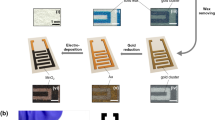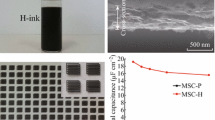Abstract
Paper-based flexible supercapacitors (SCs) show advantages due to the improved adhesion between paper and active materials, the simplified printing process and the lower cost, compared to other substrates such as plastics. Here we report the fabrication of solid-state yet flexible SCs by inkjetprinting a hybrid ink consisting of carbon quantum dots (CQDs) and graphene oxide (GO) platelets, followed by casting of polyvinyl alcohol (PVA)/sulfuric acid (H2SO4) gel electrolyte. The SC obtained from 100-time-printing of the hybrid ink shows a specific capacitance of ~1.0 mF cm−2 at a scan rate of 100 mV s−1, which is enhanced by nearly 150%; the whole device including paper substrate, gel electrolyte and active material demonstrates an energy density of 0.078 mW h cm−3 at a power density of 0.28 mW cm−3. In addition, the excellent mechanical strength of GO platelets ensures the good flexibility and mechanical robustness of the printed SCs, which show a retention of 98% in capacitance after being bended for 1,000 cycles at a bending radius of 7.6 mm. This study demonstrates a promising strategy for the large-scale preparation of low-cost, lightweight, and flexible/wearable energy storage devices based on carbon-based ink and paper substrate.
摘要
与其他柔性基底材料如塑料相比, 纸基柔性超级电容器具有印刷工艺简单、 制造价格低廉以及基底和活性材料之间具有更好的粘合力等优势. 在这里, 我们通过喷墨打印碳量子点(CQDs)和氧化石墨烯(GO)组成的混合墨水、 采用PVA/H2SO4为凝胶电解质制备了固态柔性超级电容器, 并对其性能进行了系统研究. 打印100次混合墨水获得的超级电容器在100 mV s−1的扫描速率下显示出~1.0 mF cm−2的比电容, 相比于纯GO墨水制备的超级电容器其比电容增加了150%; 通过进一步优化, 基于超级电容器整个装置(包括纸基、 凝胶电解质和活性材料)在0.28 mW cm−3的功率密度下表现出0.078 mW h cm−3的能量密度. 此外, GO薄片具有出色的机械强度, 确保超级电容器具有良好的柔韧性和机械强度, 在弯曲半径为7.6 mm的条件下弯曲1000次后, 仍保留98%的电容. 基于碳基墨水和纸张基材的喷墨打印的技术为低成本、 轻便、 灵活/可穿戴式储能装置的大规模制备提供了可能.
Similar content being viewed by others
References
Wu ZS, Feng X, Cheng HM. Recent advances in graphene-based planar micro-supercapacitors for on-chip energy storage. Natl Sci Rev, 2014, 1: 277–292
Peng L, Zhu Y, Li H, et al. Chemically integrated inorganic-graphene two-dimensional hybrid materials for flexible energy storage devices. Small, 2016, 12: 6183–6199
Ye J, Tan H, Wu S, et al. Direct laser writing of graphene made from chemical vapor deposition for flexible, integratable microsupercapacitors with ultrahigh power output. Adv Mater, 2018, 26: 1801384
Simon P, Gogotsi Y. Materials for electrochemical capacitors. Nat Mater, 2008, 7: 845–854
Kang YJ, Chung H, Han CH, et al. All-solid-state flexible supercapacitors based on papers coated with carbon nanotubes and ionic-liquid-based gel electrolytes. Nanotechnology, 2012, 23: 065401
Bonaccorso F, Colombo L, Yu G, et al. Graphene, related twodimensional crystals, and hybrid systems for energy conversion and storage. Science, 2015, 347: 1246501–1246501
Xiao X, Li T, Yang P, et al. Fiber-based all-solid-state flexible supercapacitors for self-powered systems. ACS Nano, 2012, 6: 9200–9206
Huang C, Grant PS. One-step spray processing of high power allsolid-state supercapacitors. Sci Rep, 2013, 3: 2393
Zhang X, Lin Z, Chen B, et al. Solid-state, flexible, high strength paper-based supercapacitors. J Mater Chem A, 2013, 1: 5835–5839
Hu L, Pasta M, La Mantia F, et al. Stretchable, porous, and conductive energy textiles. Nano Lett, 2010, 10: 708–714
Kang YJ, Chun SJ, Lee SS, et al. All-solid-state flexible supercapacitors fabricated with bacterial nanocellulose papers, carbon nanotubes, and triblock-copolymer ion gels. ACS Nano, 2012, 6: 6400–6406
Zheng G, Hu L, Wu H, et al. Paper supercapacitors by a solventfree drawing method. Energy Environ Sci, 2011, 4: 3368
Wang Y, Shi Y, Zhao CX, et al. Printed all-solid flexible microsupercapacitors: towards the general route for high energy storage devices. Nanotechnology, 2014, 25: 094010
Liu Z, Wu ZS, Yang S, et al. Ultraflexible in-plane micro-supercapacitors by direct printing of solution-processable electrochemically exfoliated graphene. Adv Mater, 2016, 28: 2217–2222
Kamyshny A, Magdassi S. Conductive nanomaterials for printed electronics. Small, 2014, 10: 3515–3535
Song JW, Kim J, Yoon YH, et al. Inkjet printing of single-walled carbon nanotubes and electrical characterization of the line pattern. Nanotechnology, 2008, 19: 095702
Liu W, Lu C, Li H, et al. Paper-based all-solid-state flexible microsupercapacitors with ultra-high rate and rapid frequency response capabilities. J Mater Chem A, 2016, 4: 3754–3764
Chen P, Chen H, Qiu J, et al. Inkjet printing of single-walled carbon nanotube/RuO2 nanowire supercapacitors on cloth fabrics and flexible substrates. Nano Res, 2010, 3: 594–603
Hu L, Choi JW, Yang Y, et al. Highly conductive paper for energystorage devices. Proc Natl Acad Sci USA, 2009, 106: 21490–21494
de Gans BJ, Duineveld P, Schubert U. Inkjet printing of polymers: state of the art and future developments. Adv Mater, 2004, 16: 203–213
Le L, Ervin M, Qiu H, et al. In Inkjet-printed graphene for flexible micro-supercapacitors. Nanotechnology, 2011, 67–71
Xu Y, Hennig I, Freyberg D, et al. Inkjet-printed energy storage device using graphene/polyaniline inks. J Power Sources, 2014, 248: 483–488
Wang S, Liu N, Tao J, et al. Inkjet printing of conductive patterns and supercapacitors using a multi-walled carbon nanotube/Ag nanoparticle based ink. J Mater Chem A, 2015, 3: 2407–2413
Zhang LL, Zhao X, Stoller MD, et al. Highly conductive and porous activated reduced graphene oxide films for high-power supercapacitors. Nano Lett, 2012, 12: 1806–1812
Gao W, Singh N, Song L, et al. Direct laser writing of microsupercapacitors on hydrated graphite oxide films. Nat Nanotech, 2011, 6: 496–500
Li P, Jin Z, Peng L, et al. Stretchable all-gel-state fiber-shaped supercapacitors enabled by macromolecularly interconnected 3D graphene/nanostructured conductive polymer hydrogels. Adv Mater, 2018, 30: 1800124
Peng L, Fang Z, Zhu Y, et al. Holey 2D nanomaterials for electrochemical energy storage. Adv Energy Mater, 2018, 8: 1702179
Pei Z, Hu H, Liang G, et al. Carbon-based flexible and all-solidstate micro-supercapacitors fabricated by inkjet printing with enhanced performance. Nano-Micro Lett, 2017, 9: 19
Jiang L, Sheng L, Long C, et al. Functional pillared graphene frameworks for ultrahigh volumetric performance supercapacitors. Adv Energy Mater, 2015, 5: 1500771
Byon HR, Gallant BM, Lee SW, et al. Role of oxygen functional groups in carbon nanotube/graphene freestanding electrodes for high performance lithium batteries. Adv Funct Mater, 2013, 23: 1037–1045
Zhao X, Li M, Dong H, et al. Interconnected 3 D network of graphene-oxide nanosheets decorated with carbon dots for highperformance supercapacitors. ChemSusChem, 2017, 10: 2626–2634
Chen G, Wu S, Hui L, et al. Assembling carbon quantum dots to a layered carbon for high-density supercapacitor electrodes. Sci Rep, 2016, 6: 19028
Lin L, Zhang S. Creating high yield water soluble luminescent graphene quantum dots via exfoliating and disintegrating carbon nanotubes and graphite flakes. Chem Commun, 2012, 48: 10177–10179
Mei Q, Zhang K, Guan G, et al. Highly efficient photoluminescent graphene oxide with tunable surface properties. Chem Commun, 2010, 46: 7319–7321
Miller JR, Outlaw RA, Holloway BC. Graphene electric double layer capacitor with ultra-high-power performance. Electrochim Acta, 2011, 56: 10443–10449
Zhu Y, Peng L, Fang Z, et al. Structural engineering of 2D nanomaterials for energy storage and catalysis. Adv Mater, 2018, 30: 1706347
Raymundo-Piñero E, Cadek M, Béguin F. Tuning carbon materials for supercapacitors by direct pyrolysis of seaweeds. Adv Funct Mater, 2009, 19: 1032–1039
Zhao B, Liu P, Jiang Y, et al. Supercapacitor performances of thermally reduced graphene oxide. J Power Sources, 2012, 198: 423–427
Fang Y, Luo B, Jia Y, et al. Renewing functionalized graphene as electrodes for high-performance supercapacitors. Adv Mater, 2012, 24: 6348–6355
Li L, Li F. The effect of carbonyl, carboxyl and hydroxyl groups on the capacitance of carbon nanotubes. New Carbon Mater, 2011, 26: 224–228
Yan Y, Kuila T, Kim NH, et al. Effects of acid vapour mediated oxidization on the electrochemical performance of thermally exfoliated graphene. Carbon, 2014, 74: 195–206
Hulicova-Jurcakova D, Seredych M, Lu GQ, et al. Combined effect of nitrogen- and oxygen-containing functional groups of microporous activated carbon on its electrochemical performance in supercapacitors. Adv Funct Mater, 2009, 19: 438–447
Yang F, Zhao M, Zheng B, et al. Influence of pH on the fluorescence properties of graphene quantum dots using ozonation preoxide hydrothermal synthesis. J Mater Chem, 2012, 22: 25471–25479
Bagri A, Mattevi C, Acik M, et al. Structural evolution during the reduction of chemically derived graphene oxide. Nat Chem, 2010, 2: 581–587
Xiao X, Li T, Peng Z, et al. Freestanding functionalized carbon nanotube-based electrode for solid-state asymmetric supercapacitors. Nano Energy, 2014, 6: 1–9
Gao K, Shao Z, Wu X, et al. Paper-based transparent flexible thin film supercapacitors. Nanoscale, 2013, 5: 5307–5311
Cheng Y, Lu S, Zhang H, et al. Synergistic effects from graphene and carbon nanotubes enable flexible and robust electrodes for high-performance supercapacitors. Nano Lett, 2012, 12: 4206–4211
Kim MS, Hsia B, Carraro C, et al. Flexible micro-supercapacitors with high energy density from simple transfer of photoresist-derived porous carbon electrodes. Carbon, 2014, 74: 163–169
Liu S, Xie J, Li H, et al. Nitrogen-doped reduced graphene oxide for high-performance flexible all-solid-state micro-supercapacitors. J Mater Chem A, 2014, 2: 18125–18131
Kaempgen M, Chan CK, Ma J, et al. Printable thin film supercapacitors using single-walled carbon nanotubes. Nano Lett, 2009, 9: 1872–1876
Zheng H, Zhai T, Yu M, et al. TiO2@C core–shell nanowires for high-performance and flexible solid-state supercapacitors. J Mater Chem C, 2013, 1: 225–229
Yang P, Xiao X, Li Y, et al. Hydrogenated ZnO core–shell nanocables for flexible supercapacitors and self-powered systems. ACS Nano, 2013, 7: 2617–2626
Lu X, Wang G, Zhai T, et al. Stabilized TiN nanowire arrays for high-performance and flexible supercapacitors. Nano Lett, 2012, 12: 5376–5381
Acknowledgements
This work was supported by the Thousand Talents Plan of China, the Program for New Century Excellent Talents in University, and the National Natural Science Foundation of China (51322204 and 51772282).
Author information
Authors and Affiliations
Corresponding author
Additional information
Jie Liu is a graduate student at the University of Science and Technology of China. She is currently studying in the Department of Materials Science and Engineering. Her research focuses on the energy storage of new carbon-based composites.
Yanwu Zhu is currently a Professor of the Department of Materials Science and Engineering, University of Science and Technology of China. He obtained a BSc degree in applied physics from the National University of Defense Technology in 2000, a MSc degree in physics from Peking University in 2003, and a PhD degree in physics from the National University of Singapore in 2007. He was a postdoctoral researcher at the National University of Singapore and at the University of Texas at Austin. In the last decade, he has been engaged in the preparation, characterization and property research of graphene and other novel carbon materials.
Electronic supplementary material
40843_2018_9309_MOESM1_ESM.pdf
Solid-state yet flexible supercapacitors made by inkjet-printing hybrid ink of carbon quantum dots/graphene oxide platelets on paper
Rights and permissions
About this article
Cite this article
Liu, J., Ye, J., Pan, F. et al. Solid-state yet flexible supercapacitors made by inkjet-printing hybrid ink of carbon quantum dots/graphene oxide platelets on paper. Sci. China Mater. 62, 545–554 (2019). https://doi.org/10.1007/s40843-018-9309-x
Received:
Accepted:
Published:
Issue Date:
DOI: https://doi.org/10.1007/s40843-018-9309-x




